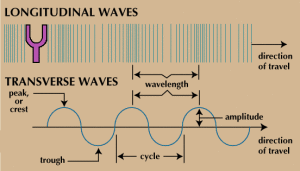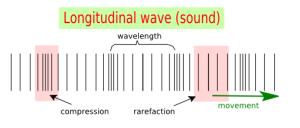What is the difference between the transverse waves and the longitudinal waves
The waves are classified according to the direction of vibration of the medium particles relative to the direction of the propagation into the transverse waves and the longitudinal waves, and they are types of wave motion.
The transverse waves
The transverse wave is formed of the crests and the troughs, During the wave propagation, the medium particles do not move from their positions, but they vibrate around their rest positions.
The disturbance in which the particles of the medium vibrate perpendicular to the direction of the wave propagation is known as the transverse wave, The crest is the highest point of the particles of the medium in the transverse wave.
The trough is the lowest point of the particles of the medium in the transverse wave, The water waves are transverse waves because the water particles vibrate in a direction perpendicular to the direction of the wave propagation.
The longitudinal waves
The longitudinal wave is formed of the compressions and the rarefactions, During the wave propagation, the medium particles don’t move from their rest positions but they vibrate around their rest positions.
The disturbance in which the particles of the medium vibrate along the direction of the wave propagation is known as the longitudinal wave, The compression is the area in the longitudinal wave at which the particles of the medium are of the highest density and pressure.
The rarefaction is the area in the longitudinal wave at which the medium particles are of the lowest density and pressure, The sound waves are the longitudinal waves because the medium particles vibrate along the direction of the waves propagation.
The crest in the transverse wave is equivalent to the compression in the longitudinal wave, and similarly, the trough is equivalent to the rarefaction.
The wave motion and the types of waves
Properties of electromagnetic waves and Light reflection
The law of the wave propagation
Mechanical waves and some technological applications of sound mechanical waves





